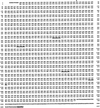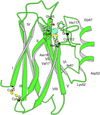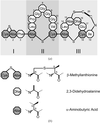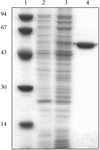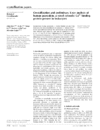issue contents
June 2000 issue

Cover illustration: Superposition of chains A, B and C showing the divergence of the C-terminal tail regions within the chorismate mutase trimer (p. 673).
research papers
The orthorhombic crystal structure of chorismate mutase from B. subtilis has been determined at 1.30 Å.
PDB reference: chorismate mutase, 1dbf
The orientation of two lobes in buffalo lactoferrin at 277 K differs considerably from that observed at 303 K but the relative orientations of domains in both lobes at two temperatures are identical. The opening of the iron-binding cleft at the exterior in the N-lobe in buffalo lactoferrin has been found to be the largest among lactoferrins from different species.
PDB reference: buffalo lactoferrin, 1biy
The X-ray structure of azurin II from A. xylosoxidans is reported in the oxidized and reduced forms at 1.75 Å resolution. The one-electron reduction causes very small changes at the Cu site which cannot be defined with confidence at the current resolution.
3D EXAFS refinement of oxidized and reduced azurin II from A. xylosoxidans has provided detailed stereochemical information for the Cu sites.
The crystal structure of the 20 amino-acid peptide antibiotic mersacidin has been determined by ab initio phasing methods based on data from a merohedrally twinned crystal containing six independent peptide molecules in the asymmetric unit.
PDB reference: mersacidin, 1qow
A difference distance matrix algorithm is presented that enables an objective comparison of related protein structures taking into account the experimental uncertainties.
TEXTAL, an automated system for building protein structures from electron-density maps, is described. This uses pattern recognition to select regions in a database of previously determined structure that are similar in a map of unknown structure. This system represents an approach to protein structure determination and has the potential to reduce the time required to interpret electron-density maps.
Image-seeking functions have proved to be useful tools in macromolecular crystallography. The application of these functions in the molecular-replacement method has been studied.
crystallization papers
The fatty-acid biosynthesis protein β-ketoacyl-ACP synthase III has been crystallized from E. coli in two crystal forms and crystallographic data obtained. Both forms diffract to better than 2.0 Å; a dry flash-cooling technique was used to collect the data.
The crystallization and preliminary X-ray analysis of high-alkaline pectate lyase from Bacillus sp. have been performed. Native data have been collected to 1.5 Å using synchrotron X-rays.
Crystals of a complex between granulocyte colony-stimulating factor and its soluble receptor have been prepared by the vapour-diffusion method. Two different crystal forms in space groups P41212 and I4122 have been produced using different crystallization conditions.
Orthorhombic crystals of DsrD protein from a sulfate-reducing bacterium have been obtained. A gold-derivative crystal has been successfully prepared.
The C-terminal His-tagged E. coli thioesterase I has been expressed, purified and crystallized. The crystals belong to tetragonal space group P41212 or P43212, with unit-cell parameters a = b = 50.85 (7), c = 171.5 (1) Å and diffract to beyond 2.4 Å resolution.
The Ebola virus matrix protein VP40 has been expressed, purified and crystallized in space group C2. Crystals diffract to 1.9 Å using synchrotron radiation.
The enzyme phosphomannomutase/phosphoglucomutase from the pathogenic bacterium P. aeruginosa has been crystallized. X-ray diffraction data have been collected on a synchrotron source to 1.75 Å
Expression, purification, crystallization and a preliminary X-ray diffraction study of Gcy1p, an aldo–keto reductase from S. cerevisiae, are described. Kinetic studies indicate that Gcy1p is indeed an enzyme possessing NADPH-dependent reductase activity.
A His-tagged form of the ι-carrageenase from A. fortis has been overproduced and crystallized allowing its X-ray structure determination.
The C-terminal sterile α-motif (SAM) domain of human p73α has been crystallized. Diffraction data to 2.54 Å was collected and the crystal parameters determined (P41212, a = b = 32.02, c = 133.84 Å). A molecular-replacement solution was obtained using the NMR structure of the same protein as a search model.
Grancalcin, specifically associated with cells originating in the bone marrow, is a cytosolic Ca2+-binding protein, which binds reversibly to secretory vesicles and plasma membranes in the presence of physiological concentrations of Ca2+. Recombinant human grancalcin has been crystallized in the presence and absence of Ca2+.
Dihydrofolate reductase from bacteriophage T4 has been crystallized in the presence of the cofactor and an inhibitor. Native data have been collected to 1.9 Å resolution using synchrotron X-rays.
Orthorhombic crystals of Ygr203p, an arsenate reductase homologue from S. cerevisiae, have been obtained. Native data have been collected to 1.9 Å resolution using Cu Kα X-rays.
Crystals of five different membrane proteins were obtained from a lipidic cubic phase matrix, thus demonstrating the general applicability of this in cubo crystallization method.
short communications
This paper demonstrates that the anomalous signal from selenomethionine-substituted proteins (as used in MAD) can be significantly enhanced by oxidation.


 journal menu
journal menu












